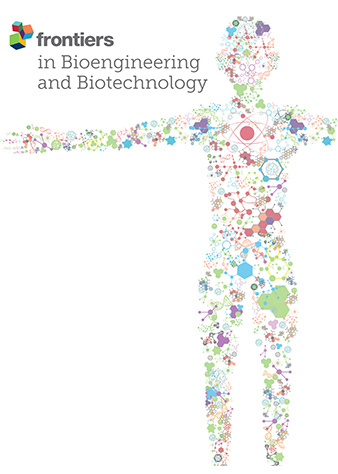Influence of surface texturing and coatings on mechanical properties and integration with bone tissue: an in silico study
IF 4.3
3区 工程技术
Q1 BIOTECHNOLOGY & APPLIED MICROBIOLOGY
引用次数: 0
Abstract
IntroductionThis investigation delves into the mechanical behaviour of titanium dental implants, a preferred choice for tooth replacement due to their superior reliability over alternative materials. The phenomenon of implant loosening, frequently induced by masticatory activities, underscores the significance of surface modification or texturing to bolster the interaction between the implant and bone tissue. This research comprehensively examines the effects of four distinct surface texturing techniques and five varied bone quality conditions on the biomechanical performance of these implants.MethodsThe scope of this study is delineated by its focus on implants of diameters 4 mm and 6 mm, with lengths measuring 9 mm and 12 mm respectively. Furthermore, the analysis incorporates the evaluation of four different coatings—hydroxyapatite, HA3TO, HA3Sr, and HA1.5TO1.5Sr—to investigate their efficacy in enhancing the osseointegration process on textured surfaces of dental implants.ResultsThe experimental design entails the assessment of stress distribution within the implant and its coatings, alongside the strain exerted on the surrounding cancellous bone, under the conditions of an average vertical biting force. A comparative analysis between solid implants and those subjected to surface texturing techniques has been conducted. This comparison elucidates the advantageous microstrain profiles presented by certain textured surfaces, which are deemed more conducive to optimal osseointegration.DiscussionNotably, across all examined textures, the application of hydroxyapatite (HA) and a modified HA composition (HA1.5TO1.5Sr) demonstrates significant improvements in mechanical stability, particularly in scenarios involving weak and very weak bone conditions. This study's findings contribute to the ongoing advancement in dental implant technology, emphasizing the critical role of surface texturing and coating strategies in promoting implant longevity and integration within the biomechanical environment of the human oral cavity.表面纹理和涂层对机械性能以及与骨组织结合的影响:一项模拟研究
导言:钛牙科种植体因其优于其他材料的可靠性而成为换牙的首选,本研究对钛牙科种植体的机械性能进行了深入探讨。种植体松动的现象经常由咀嚼活动引起,这突出表明了表面改性或纹理处理对于加强种植体与骨组织之间相互作用的重要性。本研究全面考察了四种不同的表面纹理技术和五种不同的骨质条件对这些种植体生物力学性能的影响。方法本研究的重点是直径分别为 4 毫米和 6 毫米、长度分别为 9 毫米和 12 毫米的种植体。此外,分析还包括对四种不同涂层(羟基磷灰石、HA3TO、HA3Sr 和 HA1.5TO1.5Sr)的评估,以研究它们在增强牙科种植体纹理表面骨结合过程中的功效。结果实验设计包括在平均垂直咬合力条件下,评估种植体及其涂层内部的应力分布,以及对周围松质骨施加的应变。我们对固体种植体和采用表面纹理技术的种植体进行了比较分析。讨论值得注意的是,在所有检查过的纹理中,羟基磷灰石(HA)和改性 HA 成分(HA1.5TO1.5Sr)的应用在机械稳定性方面都有显著改善,尤其是在骨质薄弱和非常薄弱的情况下。本研究的发现有助于推动牙科种植技术的不断进步,强调了表面纹理和涂层策略在促进种植体寿命以及与人体口腔生物力学环境融合方面的关键作用。
本文章由计算机程序翻译,如有差异,请以英文原文为准。
求助全文
约1分钟内获得全文
求助全文
来源期刊

Frontiers in Bioengineering and Biotechnology
Chemical Engineering-Bioengineering
CiteScore
8.30
自引率
5.30%
发文量
2270
审稿时长
12 weeks
期刊介绍:
The translation of new discoveries in medicine to clinical routine has never been easy. During the second half of the last century, thanks to the progress in chemistry, biochemistry and pharmacology, we have seen the development and the application of a large number of drugs and devices aimed at the treatment of symptoms, blocking unwanted pathways and, in the case of infectious diseases, fighting the micro-organisms responsible. However, we are facing, today, a dramatic change in the therapeutic approach to pathologies and diseases. Indeed, the challenge of the present and the next decade is to fully restore the physiological status of the diseased organism and to completely regenerate tissue and organs when they are so seriously affected that treatments cannot be limited to the repression of symptoms or to the repair of damage. This is being made possible thanks to the major developments made in basic cell and molecular biology, including stem cell science, growth factor delivery, gene isolation and transfection, the advances in bioengineering and nanotechnology, including development of new biomaterials, biofabrication technologies and use of bioreactors, and the big improvements in diagnostic tools and imaging of cells, tissues and organs.
In today`s world, an enhancement of communication between multidisciplinary experts, together with the promotion of joint projects and close collaborations among scientists, engineers, industry people, regulatory agencies and physicians are absolute requirements for the success of any attempt to develop and clinically apply a new biological therapy or an innovative device involving the collective use of biomaterials, cells and/or bioactive molecules. “Frontiers in Bioengineering and Biotechnology” aspires to be a forum for all people involved in the process by bridging the gap too often existing between a discovery in the basic sciences and its clinical application.
 求助内容:
求助内容: 应助结果提醒方式:
应助结果提醒方式:


